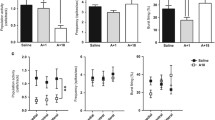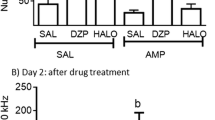Abstract
Rats were administered d-amphetamine repeatedly for 4days. After day 1 of treatment, the amphetamine-induced increases in ambulation, rearing, and stereotyped activity were augmented. However, after 4 dats treatment, the rearing and ambulatory responses became attenuated while the stereotyped activities remained augmented. Microinjection studies revealed that both the augmentation and attenuation of nonstereotyped ambulation were generated from the nucleus accumbens. The augmentation of stereotyped behaviors was generated from the caudate nucleus. Chronically treated animals who were administered 0.7 but not 1.0 mg/kg apomorphine showed augmented behavioral response. Chronic amphetamine treatment significantly decreased (3H) spiroperidol binding in both the nucleus accumbens and caudate nucleus. However, no effect on the DA-stimulated adenyl cyclase activity was observed in either brain region. It is concluded that repeated d-amphetamine administration selectively augments and attenuates d-amphetamine-induced behaviours and that these selective effects are mediated by different dopamine systems.
Similar content being viewed by others
References
Benoit JC, Delagrange G, Ruchon A, Souchon G, Sow I, Sivadon P (1969) Contribution à l'etude clinique d'un nouveau neuroleptique: Le sulpiride. Sem. Hop. Paris 45:958–964
Besson MJ, Cheramy A, Glowinski J (1971) Effects of some psychotropic drugs on dopamine synthesis in the rat striatum. J Pharmacol Exp Ther 177:196–205
Browne RG, Segal DS (1977) Metabolic and experimental factors in the behavioral response to repeated amphetamine. Pharmacol Biochem Behav 6 (5):545–552
Burt DR, Enna SJ, Creese I, Synder SH (1975) Dopamine receptor binding in the corpus striatum of mammalian brain. Proc Natl Acad Sci USA 72:4655–4659
Creese I, Burt DR, Synder SH (1975) Dopamine receptor binding: Differentiation of agonist and antagonist states with 3H-dopamine and 3H-haloperidol. Life Sci 17:993–1002
Creese I, Iversen SD (1974) The role of forebrain dopamine systems in amphetamine induced stereotyped behavior in the rat. Psychopharmacologia 39:345–357
Gnegy M, Uzunov P, Costa E (1977) Participation of an endogeneous Ca2+-binding protein activator in the development of drug-induced supersensitivity of striatal dopamine receptors. J Pharmacol Exp Ther 202:558–564
Griffith JD (1977) Structure-activity relationships of several amphetamine drugs in man. In: Ellinwood EH Jr, Kilbey MM (eds). Cocaine and other stimulants, Plenum Press, New York, p 705
Groves PM, Wilson CJ, Young SJ, Rebec GV (1975) Self-inhibition by dopaminergic neurons. Science 190:522–529
Hitzemann RJ (1979) The role of pH in the isolation of nerve ending particles which transport GABA and glutamic acid. J Neurochem 32:669–672
Hitzemann RJ, Loh HH (1974) Further studies on the effect of p-hydroxynorephedrine (PONE) on norepinephrine metabolism in the rat brain. Eur J Pharmacol 27:89–98
Hitzemann RJ, Loh HH, Craves FD, Domino EF (1973) The use of d-amphetamine pellet implantation as a model for d-amphetamine tolerance in the mouse. Psychopharmacologia 30:227–240
Hitzemann RJ, Tseng LF, Hitzemann BA, Sampath-Khanna S, Loh HH (1977) Effects of withdrwal from chronic amphetamine intoxication on exploratory and stereotyped behaviours in the rat. Psychopharm 54:295–302
Howard JL, Large BT, Wedley S, Pullar IA (1978) The effects of standard neuroleptic compounds on the binding of (3H) spiroperidol in the striatum and mesolimbic system of the rat in vitro. Life Sci 23:599–604
Howlett DR, Nahorski SR (1979) Acute and chronic amphetamine treatments modulate striatal dopamine receptor binding sites. Brain Res 161:173–178
Iversen SD (1977) Striatal function and stereotyped behavior. In: Cools AR, Lohman AHM, van den Berken JHL (eds), Psychobiology of the striatum. North Holland Publishing, Amsterdam, p 99
Jenner P, Clow A, Reaville C, Theodorou A, Marsden CD (1978a) Behavioral and biochemical comparison of dopamine receptor blockade produced by haloperidol with that produced by substituted benzamine drugs. Life Sci 23:545–550
Jenner P, Elliott NC, Clow A, Reaville C, Marsden CD (1978b) A comparison of in vitro and in vivo dopamine receptor antagonism produced by substituted benzamide drugs. J Pharm Pharmacol 30:46–48
Kehabian JW (1978) Dopamine-sensitive adenyl cyclase: A receptor mechanism for dopamine. Adv Biochem Psychopharm 19:131–154
Kilbey MM, Ellinwood EH (1977) Reverse tolerance to stimulant-induced abnormal behavior. Life Sci 20:1063–1075
Klawans HL, Margolin DI, Dava N, Crosset P (1975) Supersensitivity to d-amphetamine and apomorphine-induced stereotyped behavior induced by chronic d-amphetamine administration. J Neurol Sci 25:283–289
Konig JFR, Klippel RA (1963) The rat brain. Williams and Wilkins, Baltimore
Kosman ME, Unna DR (1968) Effects of chronic administration of the amphetamine and other stimulants on behavior. Clin Pharmacol Ther 9:240–254
Leysen J, Laduron P (1977) Differential distribution of opiate and neuroleptic receptors and dopamine-sensitive adenylate cyclase in rat brain. Life Sci 20:281–288
Leysen JE, Gommeren W, Laduron PM (1978) Piperone: a ligand of choice for neuroleptic receptors. Biochem Pharmacol 27:307–316
Lin CW, Maayani S, Wilk S (1980) The effect of typical and atypical neuroleptics on binding of (3H) spiroperidol in calf caudate. J Pharmacol Exp Ther 212 (3):462–468
Mielke DH, Gallant DM, Kessler C (1977) An evaluation of a unique new antipsychotic agent, sulpiride: effects on serum prolactin and growth hormone levels. Am J Psychiat 134:1371–1375
Post RM, Rose H (1976) Increasing effects of repetive cocaine administration in the rat. Nature 260:731–732
Roufogalis BD, Thornton M, Wade DN (1976) Specificity of the dopamine sensitive adenylate cyclase for antipsychotic antagonists. Life Sci 19:927–934
Salomon Y, Londos C, Rodbell M (1974) A highly sensitive adenylate cyclase assay. Anal Biochem 58:541–548
Seeman P, Titeler M, Tedesco J, Weinreich P, Sinclair D (1978) Brain receptors for dopamine and neuroleptics. Adv Biochem Psychopharm 19:167–176
Segal DS (1975) Behavioral and neurochemical correlates of repeated d-amphetamine administration. Adv Biochem Psychopharm 13:247–262
Stanley M, Wilk S (1979) Striatal DOPAC elevation predicts antipsychotic efficacy of metoclopramide. Life Sci 24:1907–1912
Stripling JS, Ellinwood EH, Jr (1977a) Potentiation of the behavioral and convulsant effects of cocaine by chronic administration in the rat. Pharmacol Biochem Behav 6:571–579
Spripling JS, Ellinwood EH, Jr (1977b) Sensitization to cocaine following chronic administration in the rat. In: Ellinwood EH, Jr, Kilbey MM (eds). Cocaine and other stimulants, Plenum Press, New York, p 327
Ungerstedt U, Ljungberg T, Schultz W (1978) Dopamine receptor mechanisms: Behavioral and electrophysiological studies. Adv Biochem Psychopharm 19:311–321
Walters JR, Roth RH (1974) Dopaminergic neurons: Drug-induced antagonism of the increase in lyrosine hydroxylase activity produced by cessation of impulse flow. J Pharmacol Exp Ther 191:82–91
Author information
Authors and Affiliations
Rights and permissions
About this article
Cite this article
Hitzemann, R., Wu, J., Hom, D. et al. Brain locations controlling the behavioral effects of chronic amphetamine intoxication. Psychopharmacology 72, 93–101 (1980). https://doi.org/10.1007/BF00433812
Received:
Accepted:
Issue Date:
DOI: https://doi.org/10.1007/BF00433812




